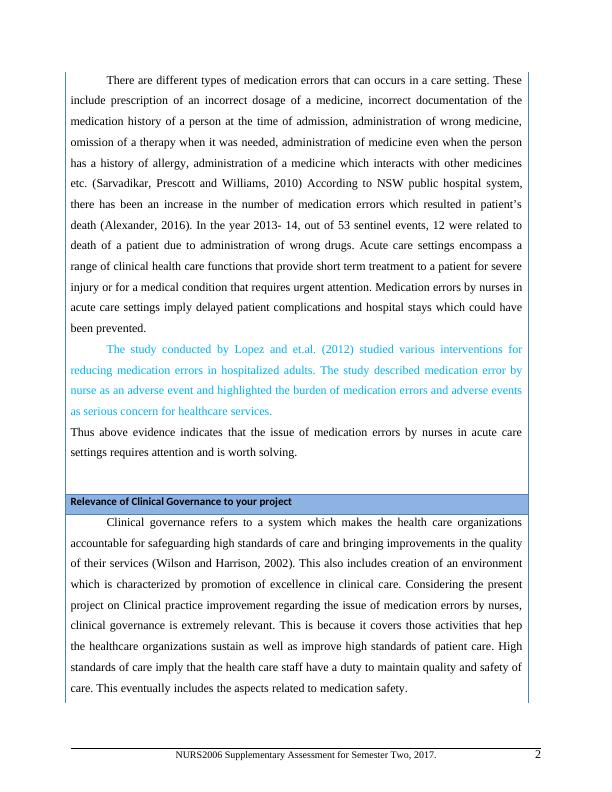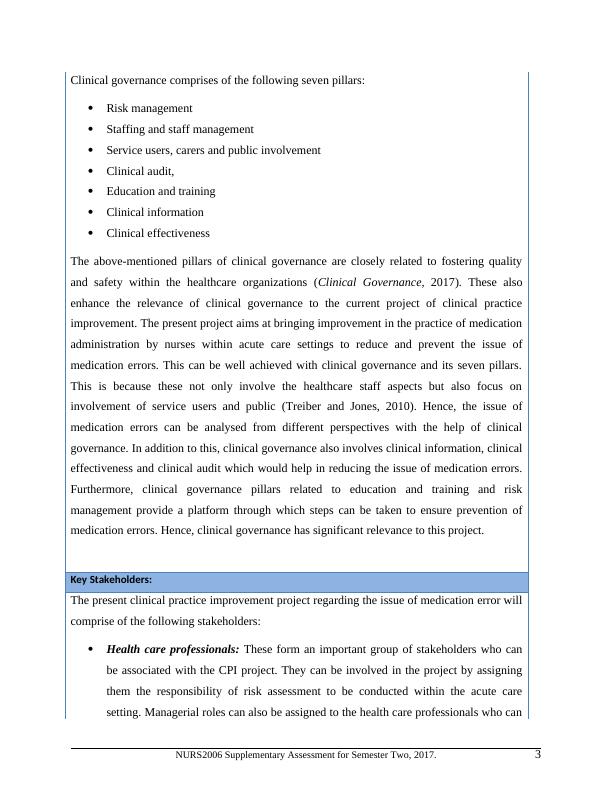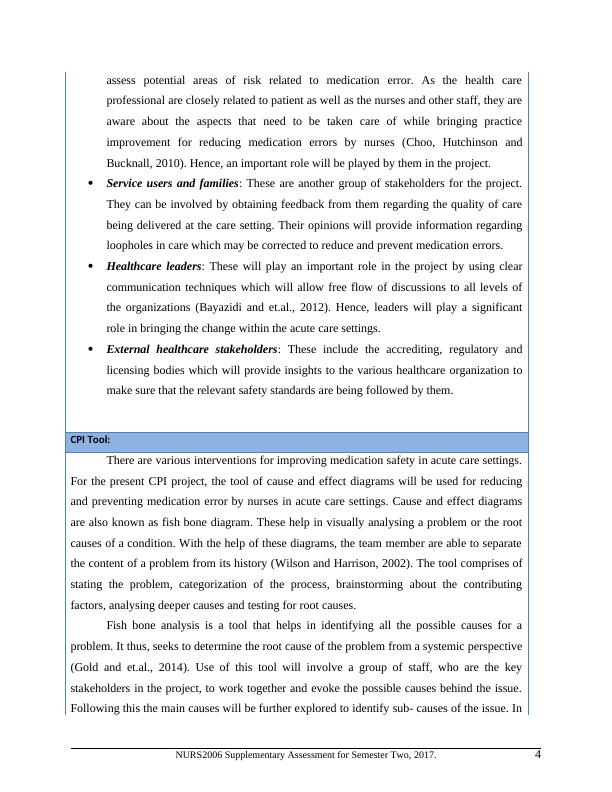NURS2006 Supplementary Assessment
12 Pages5338 Words55 Views
Added on 2020-06-06
NURS2006 Supplementary Assessment
Added on 2020-06-06
ShareRelated Documents
NURS2006 SUPPLEMENTARY ASSESSMENTClinical Practice Improvement Project ReportAim of the project is “To analyse the issue of medication errors, their possible causes andbring improvement in the practice of medication administration implementing suitableinterventions”.Background and Evidence that the issue is worth solving: A medication error is defined as a preventable event that leads to patient harm due toinappropriate medication which is in the control of heath care professionals or the patienthimself. Administration of medication is a complex process that involves multiple stepsincluding prescribing, transcribing, dispensing and administering drugs. It is considered toplay an important role in patient safety. Error can occur at any step and may place thepatient’s life at risk. Medication errors are considered to be the most common healththreatening mistakes and considerably affect the patient care. Overwork and systemic issuesmay lead to medication errors (Keers and et.al., 2013). Though these may be caused by all themembers of healthcare team, however, medications errors by nurses is more common. This isbecause majority of medical orders are executed by the nurses. Also, a considerable portionof their time is spent by the nurses for administering medications in the hospital. Bothdeveloped and developing countries have high rates of nursing medication errors. InAustralia, there are approximately 230, 000 medication related hospital admissions per year(Roughead and et.al., 2016). The country incurs an annual cost of AU$1.2 billion due tomedication related hospital admissions. Deaths as a result of medication errors are not only tragic for the patients and families,but also for the healthcare staff that is responsible. Medication error is a serious concern as itleads to adverse outcomes in the form of increased duration of hospitalization, increasedmortality and increased medical expenses (Flynn and et.al. 2012). Medication errors not onlycosts the nation in the form of monetary aspects, but these also costs in terms of loss of truston healthcare services. This eventually stems patient dissatisfaction and degrades the moraleof nurses as well as other healthcare staff. NURS2006 Supplementary Assessment for Semester Two, 2017.1

There are different types of medication errors that can occurs in a care setting. Theseinclude prescription of an incorrect dosage of a medicine, incorrect documentation of themedication history of a person at the time of admission, administration of wrong medicine,omission of a therapy when it was needed, administration of medicine even when the personhas a history of allergy, administration of a medicine which interacts with other medicinesetc. (Sarvadikar, Prescott and Williams, 2010) According to NSW public hospital system,there has been an increase in the number of medication errors which resulted in patient’sdeath (Alexander, 2016). In the year 2013- 14, out of 53 sentinel events, 12 were related todeath of a patient due to administration of wrong drugs. Acute care settings encompass arange of clinical health care functions that provide short term treatment to a patient for severeinjury or for a medical condition that requires urgent attention. Medication errors by nurses inacute care settings imply delayed patient complications and hospital stays which could havebeen prevented. The study conducted by Lopez and et.al. (2012) studied various interventions forreducing medication errors in hospitalized adults. The study described medication error bynurse as an adverse event and highlighted the burden of medication errors and adverse eventsas serious concern for healthcare services. Thus above evidence indicates that the issue of medication errors by nurses in acute caresettings requires attention and is worth solving. Relevance of Clinical Governance to your projectClinical governance refers to a system which makes the health care organizationsaccountable for safeguarding high standards of care and bringing improvements in the qualityof their services (Wilson and Harrison, 2002). This also includes creation of an environmentwhich is characterized by promotion of excellence in clinical care. Considering the presentproject on Clinical practice improvement regarding the issue of medication errors by nurses,clinical governance is extremely relevant. This is because it covers those activities that hepthe healthcare organizations sustain as well as improve high standards of patient care. Highstandards of care imply that the health care staff have a duty to maintain quality and safety ofcare. This eventually includes the aspects related to medication safety. NURS2006 Supplementary Assessment for Semester Two, 2017.2

Clinical governance comprises of the following seven pillars:Risk managementStaffing and staff management Service users, carers and public involvementClinical audit, Education and training Clinical information Clinical effectiveness The above-mentioned pillars of clinical governance are closely related to fostering qualityand safety within the healthcare organizations (Clinical Governance, 2017). These alsoenhance the relevance of clinical governance to the current project of clinical practiceimprovement. The present project aims at bringing improvement in the practice of medicationadministration by nurses within acute care settings to reduce and prevent the issue ofmedication errors. This can be well achieved with clinical governance and its seven pillars.This is because these not only involve the healthcare staff aspects but also focus oninvolvement of service users and public (Treiber and Jones, 2010). Hence, the issue ofmedication errors can be analysed from different perspectives with the help of clinicalgovernance. In addition to this, clinical governance also involves clinical information, clinicaleffectiveness and clinical audit which would help in reducing the issue of medication errors.Furthermore, clinical governance pillars related to education and training and riskmanagement provide a platform through which steps can be taken to ensure prevention ofmedication errors. Hence, clinical governance has significant relevance to this project. Key Stakeholders:The present clinical practice improvement project regarding the issue of medication error willcomprise of the following stakeholders:Health care professionals: These form an important group of stakeholders who canbe associated with the CPI project. They can be involved in the project by assigningthem the responsibility of risk assessment to be conducted within the acute caresetting. Managerial roles can also be assigned to the health care professionals who canNURS2006 Supplementary Assessment for Semester Two, 2017.3

assess potential areas of risk related to medication error. As the health careprofessional are closely related to patient as well as the nurses and other staff, they areaware about the aspects that need to be taken care of while bringing practiceimprovement for reducing medication errors by nurses (Choo, Hutchinson andBucknall, 2010). Hence, an important role will be played by them in the project.Service users and families: These are another group of stakeholders for the project.They can be involved by obtaining feedback from them regarding the quality of carebeing delivered at the care setting. Their opinions will provide information regardingloopholes in care which may be corrected to reduce and prevent medication errors.Healthcare leaders: These will play an important role in the project by using clearcommunication techniques which will allow free flow of discussions to all levels ofthe organizations (Bayazidi and et.al., 2012). Hence, leaders will play a significantrole in bringing the change within the acute care settings. External healthcare stakeholders: These include the accrediting, regulatory andlicensing bodies which will provide insights to the various healthcare organization tomake sure that the relevant safety standards are being followed by them. CPI Tool:There are various interventions for improving medication safety in acute care settings.For the present CPI project, the tool of cause and effect diagrams will be used for reducingand preventing medication error by nurses in acute care settings. Cause and effect diagramsare also known as fish bone diagram. These help in visually analysing a problem or the rootcauses of a condition. With the help of these diagrams, the team member are able to separatethe content of a problem from its history (Wilson and Harrison, 2002). The tool comprises ofstating the problem, categorization of the process, brainstorming about the contributingfactors, analysing deeper causes and testing for root causes.Fish bone analysis is a tool that helps in identifying all the possible causes for aproblem. It thus, seeks to determine the root cause of the problem from a systemic perspective(Gold and et.al., 2014). Use of this tool will involve a group of staff, who are the keystakeholders in the project, to work together and evoke the possible causes behind the issue.Following this the main causes will be further explored to identify sub- causes of the issue. InNURS2006 Supplementary Assessment for Semester Two, 2017.4

End of preview
Want to access all the pages? Upload your documents or become a member.
Related Documents
Medication Safety: Factors, Consequences, and Strategies for Preventionlg...
|5
|2132
|185
5 MEDICATION ERRORS MEDICATION ERRORS MEDICATION ERRORS Name Institutional affiliationlg...
|5
|1789
|361
Implementing Evidence Based Practice in Adult Nursing PDFlg...
|45
|4126
|59
Written Report: Medication Safety | Assignmentlg...
|4
|1914
|17
(Solved) Essay on Medication Errorlg...
|12
|3254
|837
Medical Error Research 2022lg...
|11
|2551
|25
